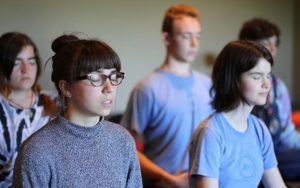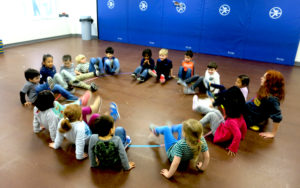Improve Emotion Regulation in Teacher Trainees with Mindfulness
By John M. de Castro, Ph.D.
“Mindful emotion regulation represents the capacity to remain mindfully aware at all times, irrespective of the apparent valence or magnitude of any emotion that is experienced. It does not entail suppression of the emotional experience, nor any specific attempts to reappraise or alter it in any way. Instead, MM involves a systematic retraining of awareness and nonreactivity, leading to defusion from whatever is experienced, and allowing the individual to more consciously choose those thoughts, emotions and sensations they will identify with, rather than habitually reacting to them.” – Richard Chambers
Mindfulness practice has been shown to improve emotions and their regulation. Practitioners demonstrate more positive and less negative emotions and the ability to fully sense and experience emotions, while responding to them in appropriate and adaptive ways. In other words, mindful people are better able to experience yet control their responses to emotions. The ability of mindfulness training to improve emotion regulation is thought to be the basis for a wide variety of benefits that mindfulness provides to mental health and the treatment of mental illness especially depression and anxiety disorders.
Teachers experience burnout at high rates. Roughly a half a million teachers out of a workforce of three million, leave the profession each year and the rate is almost double in poor schools compared to affluent schools. Indeed, nearly half of new teachers leave in their first five years. Burnout frequently results from emotional exhaustion. Hence, methods of improving teacher emotion regulation need to be studied. Intervening during teacher training may be a useful strategy as improving emotion regulation very early before the teaching career begins may prepare the teachers to better deal with the difficulties of their profession.
In today’s Research News article “Improving emotion regulation and mood in teacher trainees: Effectiveness of two mindfulness trainings.” (See summary below or view the full text of the study at: https://www.ncbi.nlm.nih.gov/pmc/articles/PMC6749600/), Wimmer and colleagues recruited college students who intended to become school teachers and assigned them to one of four conditions, mindfulness training with yoga, mindfulness training without yoga, awareness training, or no-treatment. The mindfulness training was based upon Mindfulness-Based Stress Reduction (MBSR). The modified MBSR program consisted of 7 weekly 1.5-hour group sessions involving meditation, yoga, body scan, and discussion. The teachers are also encouraged to perform 20 minutes of daily practice. Awareness training occurred on a similar schedule and emphasized reflections on consciousness and awareness. They were measured before and after training for emotion regulation, response style, and positive and negative emotions.
They found that in comparison to the no-treatment control and baseline both mindfulness groups had significant increases in reappraisal and decreases in symptom‐focused rumination, distraction, and depressive mood. These effects of mindfulness training were found to be, in part, mediated by the distraction strategy of emotion regulation. There were no significant differences in the effects of mindfulness training with and without yoga on emotion regulation or mood.
These results suggest that mindfulness training regardless of whether yoga is included is effective in increasing emotion regulation in college students aspiring to become teachers. It is interesting that distraction was to some extent a mediator of the effects of mindfulness training. This strategy involves dealing with strong emotions by shifting attention to more pleasant aspects of the situation. Mindfulness training, by improving attentional control, may facilitate the ability to shift attention to other distracting areas.
It is not known whether these effects of mindfulness training are lasting and may influence the students’ abilities to deal with the stresses of teaching in the future. It would be hoped that mindfulness training may help to prepare prospective teachers to effectively work with the emotions that arise from their profession. This would then improve their resistance to professional burnout. It remains for future research to investigate the longevity of the emotion regulation improvements.
So, improve emotion regulation in teacher trainees with mindfulness.
“our emotions don’t have to take over your life or interfere with your important relationships when you learn how to understand, manage, and respond to your emotions more effectively. Become mindful of your own personal tendencies and emotional triggers. Notice what situations tend to prompt emotional responses in you. When you increase self-knowledge in this way, you are better prepared to competently and confidently employ emotion regulation coping skills no matter what the situation.” – Laura Chang
CMCS – Center for Mindfulness and Contemplative Studies
This and other Contemplative Studies posts are also available on Google+ https://plus.google.com/106784388191201299496/posts and on Twitter @MindfulResearch
Study Summary
Wimmer, L., von Stockhausen, L., & Bellingrath, S. (2019). Improving emotion regulation and mood in teacher trainees: Effectiveness of two mindfulness trainings. Brain and behavior, 9(9), e01390. doi:10.1002/brb3.1390
Abstract
Background/Objective
The present research investigated potential effects of mindfulness training on emotion regulation and mood of future schoolteachers in a nonrandomized pre–post design, and whether these are influenced by the yoga component of mindfulness‐based stress reduction (MBSR) and/or by homework practice.
Method
N = 169 university students received either mindfulness training (experimental groups), awareness activities (active control group), or no training (passive control group), in the context of university seminars. Allocation to groups was bound by the seminar chosen by participants, and in that sense was self‐selected. Mindfulness was trained in two adapted MBSR courses, one of which including yoga, and the other excluding yoga.
Results
Specific benefits of both mindfulness training groups were observed for emotion regulation in terms of an increase in cognitive reappraisal and a reduction in symptom‐focused rumination as well as depressive mood. No benefits of mindfulness training were observed for reductions in expressive suppression, self‐focused rumination, anxious, and negative mood or an increase in distraction and positive mood respectively. Mindfulness training with and without yoga was mostly equally effective. Outcomes were largely not moderated by practice quantity or quality, but reductions in depressive mood were mediated by gains in reappraisal and distraction.
Conclusions
Mindfulness training can be implemented in the context of university seminars to foster advantageous emotion regulation strategies and lower depressive mood in future schoolteachers. Discontinuing yoga within mindfulness interventions does not seem to reduce training benefits.
https://www.ncbi.nlm.nih.gov/pmc/articles/PMC6749600/









